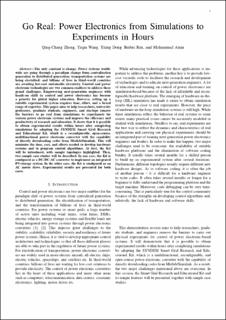| dc.contributor.author | Zhong, Qing-Chang | |
| dc.contributor.author | Wang, Yeqing | |
| dc.contributor.author | Dong, Yiting | |
| dc.contributor.author | Ren, Beibei | |
| dc.contributor.author | Amin, Mohammad | |
| dc.date.accessioned | 2021-09-21T11:05:43Z | |
| dc.date.available | 2021-09-21T11:05:43Z | |
| dc.date.created | 2020-09-18T16:38:08Z | |
| dc.date.issued | 2020 | |
| dc.identifier.citation | IEEE Power Electronics Magazine. 2020, 52-61. | en_US |
| dc.identifier.issn | 2329-9207 | |
| dc.identifier.uri | https://hdl.handle.net/11250/2779824 | |
| dc.description.abstract | The only constant is change-power systems worldwide are going through a paradigm change from centralized generation to distributed generation; transportation systems are being electrified; and billions of lives in third-world countries are awaiting low-cost sustainable electricity. Control and power electronic technologies are two common enablers to address these grand challenges. Empowering next-generation engineers with hands-on skills in control and power electronics has become a priority for global higher education. However, setting up a suitable experimental system requires time, effort, and a broad range of expertise. This article aims to help researchers, university professors, graduate students, and engineers lower the barriers to go real from simulations to experiments for various power electronic systems and improve the efficiency and productivity of research, development, and education. It shows that it is possible to obtain experimental results within hours after completing simulations by adopting the SYNDEM Smart Grid Research and Educational Kit, which is a reconfigurable, opensource, multifunctional power electronic converter with the capability of directly downloading codes from MATLAB/Simulink. This minimizes the time, cost, and efforts needed to develop hardware systems and removes the burden of coding. After briefly introducing the SYNDEM kit and highlighting the automatic code generation capability, two case studies will be illustrated: an ac motor drive and a dc-dc-ac converter for an integrated PV-storage system. | en_US |
| dc.language.iso | eng | en_US |
| dc.publisher | Institute of Electrical and Electronics Engineers (IEEE) | en_US |
| dc.relation.uri | https://ieeexplore.ieee.org/stamp/stamp.jsp?isnumber=9198152 | |
| dc.title | Go Real: Power Electronics From Simulations to Experiments in Hours: Versatile Experimental Tool for Next Generation Engineers | en_US |
| dc.type | Peer reviewed | en_US |
| dc.type | Journal article | en_US |
| dc.description.version | acceptedVersion | en_US |
| dc.rights.holder | © IEEE. Personal use of this material is permitted. Permission from IEEE must be obtained for all other uses, in any current or future media, including reprinting/republishing this material for advertising or promotional purposes, creating new collective works, for resale or redistribution to servers or lists, or reuse of any copyrighted component of this work in other works. | en_US |
| dc.source.pagenumber | 52-61 | en_US |
| dc.source.journal | IEEE Power Electronics Magazine | en_US |
| dc.identifier.doi | 10.1109/MPEL.2020.3011300 | |
| dc.identifier.cristin | 1831287 | |
| cristin.ispublished | true | |
| cristin.fulltext | preprint | |
| cristin.qualitycode | 1 | |
